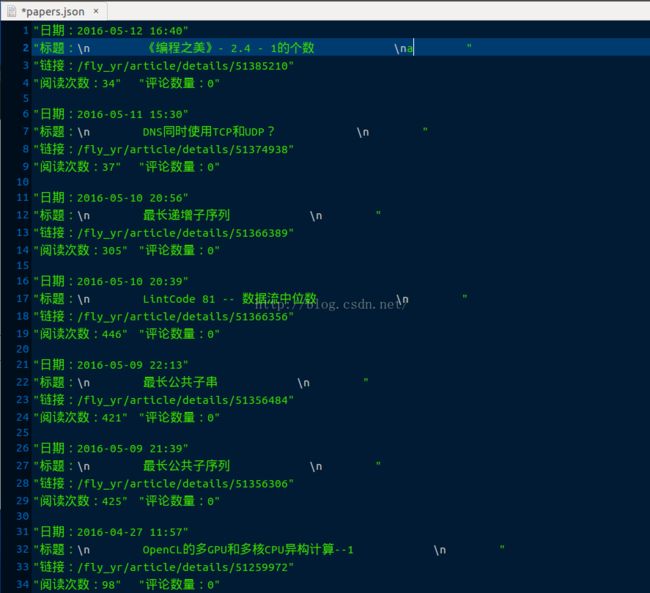Python2 爬虫(九) -- Scrapy & BeautifulSoup之再爬CSDN博文
序
我的Python3爬虫(五)博文使用utllib基本函数以及正则表达式技术实现了爬取csdn全部博文信息的任务。
链接: Python3 爬虫(五) -- 单线程爬取我的CSDN全部博文
上一篇 Python3 爬虫(八) -- BeautifulSoup之再次爬取CSDN博文,我们就利用BeautifulSoup4重新实现了一次爬取csdn博文的任务。
那么,既然认识了Scrapy和BeautifulSoup,哪有不让它们合作一下的道理呢?不过,既然要使用Scrapy框架,我不得不又转战Ubuntu,使用Python2.7了。还是希望Python3能够尽快的支持Scrapy框架哦~
嘿嘿,我又不厌其烦的继续爬CSDN博文了,问我为什么 ?也没啥,只不过是想做下简单对比而已,当然你也可以爬别的东西啦~~~
这次博客首页主题没变,所以就不重复展示了,参看
爬虫(八)即可。
创建Scrapy项目
首先,利用命令scrapy startproject csdnSpider创建我们的爬虫项目;
然后,在spiders目录下,创建CSDNSpider.py文件,这是我们主程序所在文件,目录结构如下:
定义Item
找到并打开items.py文件,定义我们需要爬取的元素:
# -*- coding: utf-8 -*-
# Define here the models for your scraped items
#
# See documentation in:
# http://doc.scrapy.org/en/latest/topics/items.html
import scrapy
from scrapy.item import Item,Field
class CsdnspiderItem(scrapy.Item):
# define the fields for your item here like:
# name = scrapy.Field()
pass
class PaperItem(Item):
title = Field() #博文标题
link = Field() #博文链接
writeTime = Field() #日志编写时间
readers = Field() #阅读次数
comments = Field() #评论数
实现CSDNSpider
打开创建的CSDNSpider.py文件,实现代码:
# -*- coding: UTF-8 -*-
############################################################################
# 程序:CSDN博客爬虫
# 功能:抓取我的CSDN全部博文
# 时间:2016/06/01
# 作者:yr
#############################################################################
import scrapy, re, json, sys
# 导入框架内置基本类class scrapy.spider.Spider
try:
from scrapy.spider import Spider
except:
from scrapy.spider import BaseSpider as Spider
# 导入爬取一般网站常用类class scrapy.contrib.spiders.CrawlSpider和规则类Rule
from scrapy.contrib.spiders import CrawlSpider, Rule
from scrapy.contrib.linkextractors.lxmlhtml import LxmlLinkExtractor
from bs4 import BeautifulSoup
from csdnSpider.items import PaperItem
# 设置编码格式
reload(sys)
sys.setdefaultencoding('utf-8')
add = 0
class CSDNPaperSpider(CrawlSpider):
name = "csdnSpider"
allowed_domains = ["csdn.net"]
# 定义爬虫的入口网页
start_urls = ["http://blog.csdn.net/fly_yr/article/list/1"]
# 自定义规则
rules = [Rule(LxmlLinkExtractor(allow=('/article/list/\d{,2}')), follow=True, callback='parseItem')]
# 定义提取网页数据到Items中的实现函数
def parseItem(self, response):
global add
items = []
data = response.body
soup = BeautifulSoup(data, "html5lib")
# 找到所有的博文代码模块
sites = soup.find_all('div', "list_item article_item")
for site in sites:
item = PaperItem()
# 标题、链接、日期、阅读次数、评论个数
item['title'] = site.find('span', "link_title").a.get_text()
item['link']= site.find('span', "link_title").a.get('href')
item['writeTime'] = site.find('span', "link_postdate").get_text()
item['readers'] = re.findall(re.compile(r'\((.*?)\)'), site.find('span', "link_view").get_text())[0]
item['comments'] = re.findall(re.compile(r'\((.*?)\)'), site.find('span', "link_comments").get_text())[0]
add += 1
items.append(item)
print("The total number:",add)
return items
定义pipeline
找到并打开pipelines.py文件,添加代码:
# -*- coding: utf-8 -*-
# Define your item pipelines here
#
# Don't forget to add your pipeline to the ITEM_PIPELINES setting
# See: http://doc.scrapy.org/en/latest/topics/item-pipeline.html
import scrapy
from scrapy import signals
import json, codecs
class CsdnspiderPipeline(object):
def process_item(self, item, spider):
return item
class JsonWithEncodingCSDNPipeline(object):
def __init__(self):
self.file = codecs.open('papers.json', 'w', encoding='utf-8')
def process_item(self, item, spider):
writeTime = json.dumps("日期:"+str(item['writeTime']),ensure_ascii=False) + "\n"
title = json.dumps("标题:"+str(item['title']),ensure_ascii=False)+ "\n"
link = json.dumps("链接:"+str(item['link']),ensure_ascii=False)+ "\n"
readers = json.dumps("阅读次数:"+str(item['readers']),ensure_ascii=False)+ "\t"
comments = json.dumps("评论数量:"+str(item['comments']),ensure_ascii=False)+ "\n\n"
line = writeTime + title + link + readers + comments
self.file.write(line)
return item
def spider_closed(self, spider):
self.file.close()
修改设置文件
找到并打开setting.py文件:# -*- coding: utf-8 -*-
# Scrapy settings for csdnSpider project
#
# For simplicity, this file contains only the most important settings by
# default. All the other settings are documented here:
#
# http://doc.scrapy.org/en/latest/topics/settings.html
#
BOT_NAME = 'csdnSpider'
SPIDER_MODULES = ['csdnSpider.spiders']
NEWSPIDER_MODULE = 'csdnSpider.spiders'
# Crawl responsibly by identifying yourself (and your website) on the user-agent
#USER_AGENT = 'csdnSpider (+http://www.yourdomain.com)'
ITEM_PIPELINES = {
'csdnSpider.pipelines.JsonWithEncodingCSDNPipeline': 300,
}
LOG_LEVEL = 'INFO'
运行
在项目根目录下运行scrapy crawl csdnSpider,得到结果:
当前我的博文共有394篇,结果正确。打开项目根目录下的papers.json文件,查看爬取的博文信息:

GitHub完整代码链接,戳我哦~~~


